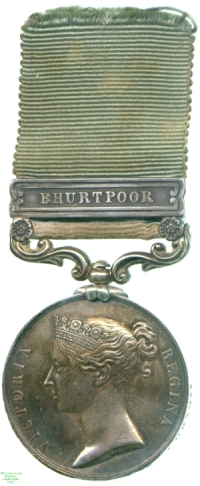
Obverse, a bust of Queen Victoria

Reverse, Victory seated facing left before a palm and war spoils, holding a laurel branch and wreath

Obverse, a bust of Queen Victoria |

Reverse, Victory seated facing left before a palm and war spoils, holding a laurel branch and wreath |
The numerous campaigns of the forces of the British East India Company were not officially recognised with a medal until 1851, in the same move as that which created the Military and Naval General Service Medals for service in the contemporary French Revolutionary and Napoleonic Wars. The resulting Army of India Army of India medal covered battles from 1799 to 1826 in a theatre where many conflicts had subsequently arisen, so many of those involved were no longer living. Queen Victoria, by whose order the medal was issued and whose bust it therefore carried, was likewise not on the throne for the actions for which it was awarded.
The bar for Bhurtpoor relates to a siege of the city of Bharatpur, capital of the Jat Empire. In 1825 the Rajah of Bharatpur had died, and his infant son been imprisoned by a cousin who then took the throne and began to voice decidedly anti-British sentiments. British forces were therefore sent to capture the legendarily-impregnable city, which they did at length by mining in January 1826. The infant Rajah was restored, but the ramparts of his city were levelled.
Awarded the medal for this campaign was Private J. Andrews of the 11th Light Dragoons, whose medal this is. Lester Watson purchased it from the dealer Gifford at some point before 1928.